MHR System: Requirements, Cloud Solutions, and SDLC Report
VerifiedAdded on 2019/10/18
|9
|2632
|430
Report
AI Summary
This report provides a comprehensive analysis of the requirements for a Medical Healthcare Record (MHR) system. It begins by defining non-functional requirements, emphasizing aspects like validity, accuracy, reliability, performance, security, usability, and data synchronization. The report then reviews cloud-based solutions for healthcare, outlining the advantages such as cost reduction, improved patient-doctor collaboration, and flexible access to records, while also addressing drawbacks like data security concerns, dependence on internet connectivity, and integration challenges. Furthermore, the report explores Software Development Life Cycle (SDLC) approaches, specifically comparing predictive and adaptive models. It details the pros and cons of each, highlighting predictive SDLC's structured approach versus adaptive SDLC's flexibility and responsiveness to change. The report concludes by advocating for an adaptive approach, emphasizing its adaptability to evolving user needs and the importance of organizational readiness for resource investment and cultural fit.
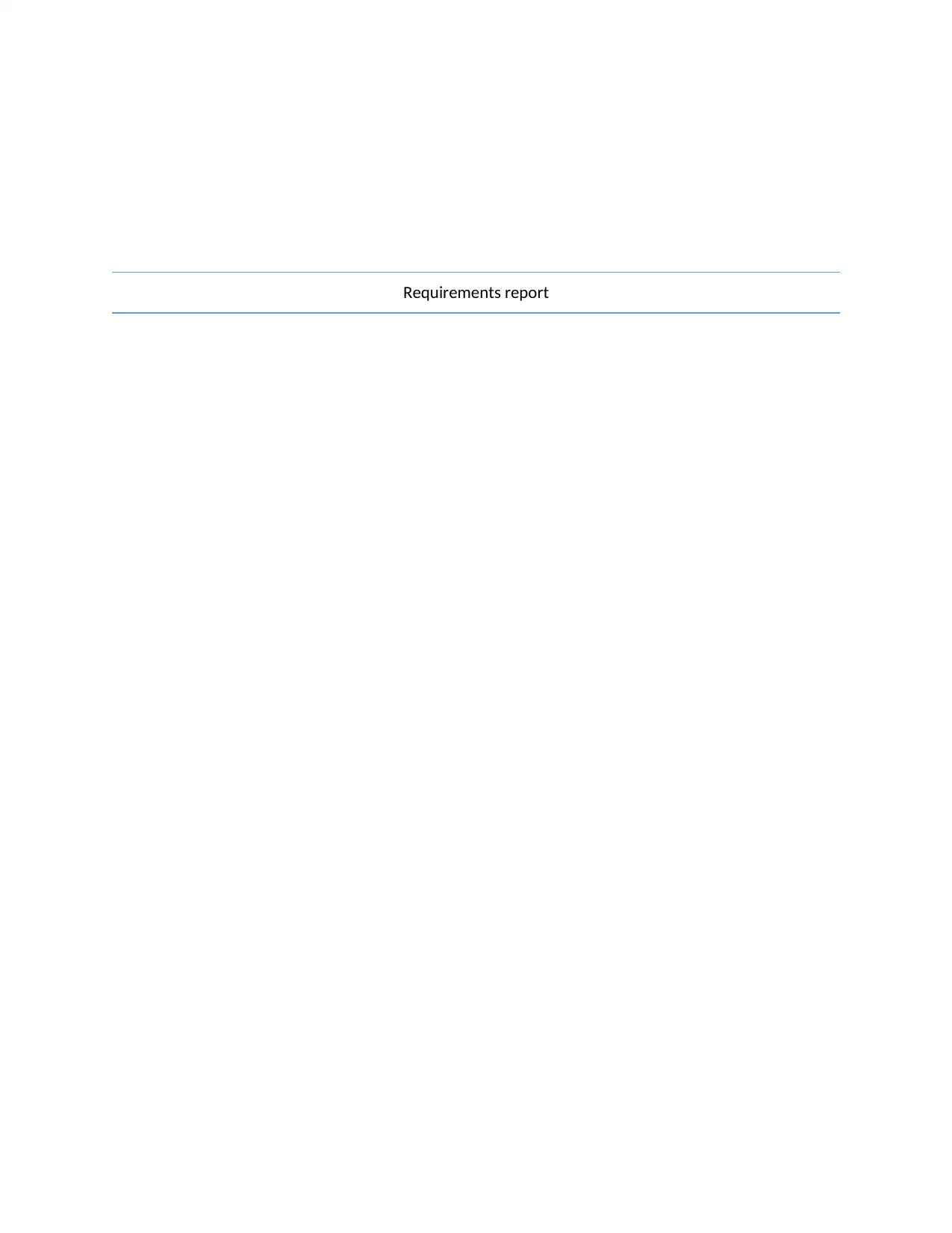
Requirements report
Paraphrase This Document
Need a fresh take? Get an instant paraphrase of this document with our AI Paraphraser
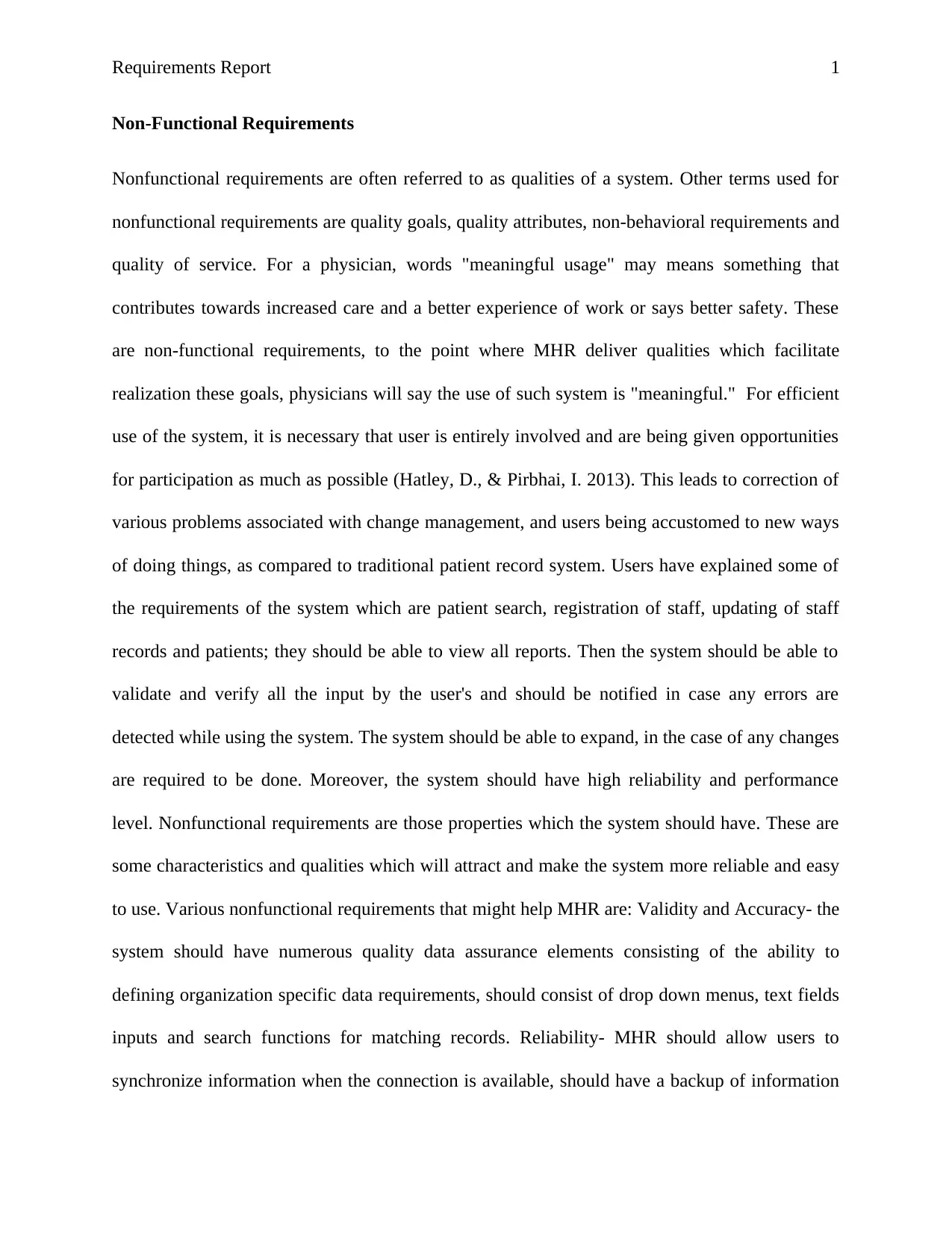
Requirements Report 1
Non-Functional Requirements
Nonfunctional requirements are often referred to as qualities of a system. Other terms used for
nonfunctional requirements are quality goals, quality attributes, non-behavioral requirements and
quality of service. For a physician, words "meaningful usage" may means something that
contributes towards increased care and a better experience of work or says better safety. These
are non-functional requirements, to the point where MHR deliver qualities which facilitate
realization these goals, physicians will say the use of such system is "meaningful." For efficient
use of the system, it is necessary that user is entirely involved and are being given opportunities
for participation as much as possible (Hatley, D., & Pirbhai, I. 2013). This leads to correction of
various problems associated with change management, and users being accustomed to new ways
of doing things, as compared to traditional patient record system. Users have explained some of
the requirements of the system which are patient search, registration of staff, updating of staff
records and patients; they should be able to view all reports. Then the system should be able to
validate and verify all the input by the user's and should be notified in case any errors are
detected while using the system. The system should be able to expand, in the case of any changes
are required to be done. Moreover, the system should have high reliability and performance
level. Nonfunctional requirements are those properties which the system should have. These are
some characteristics and qualities which will attract and make the system more reliable and easy
to use. Various nonfunctional requirements that might help MHR are: Validity and Accuracy- the
system should have numerous quality data assurance elements consisting of the ability to
defining organization specific data requirements, should consist of drop down menus, text fields
inputs and search functions for matching records. Reliability- MHR should allow users to
synchronize information when the connection is available, should have a backup of information
Non-Functional Requirements
Nonfunctional requirements are often referred to as qualities of a system. Other terms used for
nonfunctional requirements are quality goals, quality attributes, non-behavioral requirements and
quality of service. For a physician, words "meaningful usage" may means something that
contributes towards increased care and a better experience of work or says better safety. These
are non-functional requirements, to the point where MHR deliver qualities which facilitate
realization these goals, physicians will say the use of such system is "meaningful." For efficient
use of the system, it is necessary that user is entirely involved and are being given opportunities
for participation as much as possible (Hatley, D., & Pirbhai, I. 2013). This leads to correction of
various problems associated with change management, and users being accustomed to new ways
of doing things, as compared to traditional patient record system. Users have explained some of
the requirements of the system which are patient search, registration of staff, updating of staff
records and patients; they should be able to view all reports. Then the system should be able to
validate and verify all the input by the user's and should be notified in case any errors are
detected while using the system. The system should be able to expand, in the case of any changes
are required to be done. Moreover, the system should have high reliability and performance
level. Nonfunctional requirements are those properties which the system should have. These are
some characteristics and qualities which will attract and make the system more reliable and easy
to use. Various nonfunctional requirements that might help MHR are: Validity and Accuracy- the
system should have numerous quality data assurance elements consisting of the ability to
defining organization specific data requirements, should consist of drop down menus, text fields
inputs and search functions for matching records. Reliability- MHR should allow users to
synchronize information when the connection is available, should have a backup of information
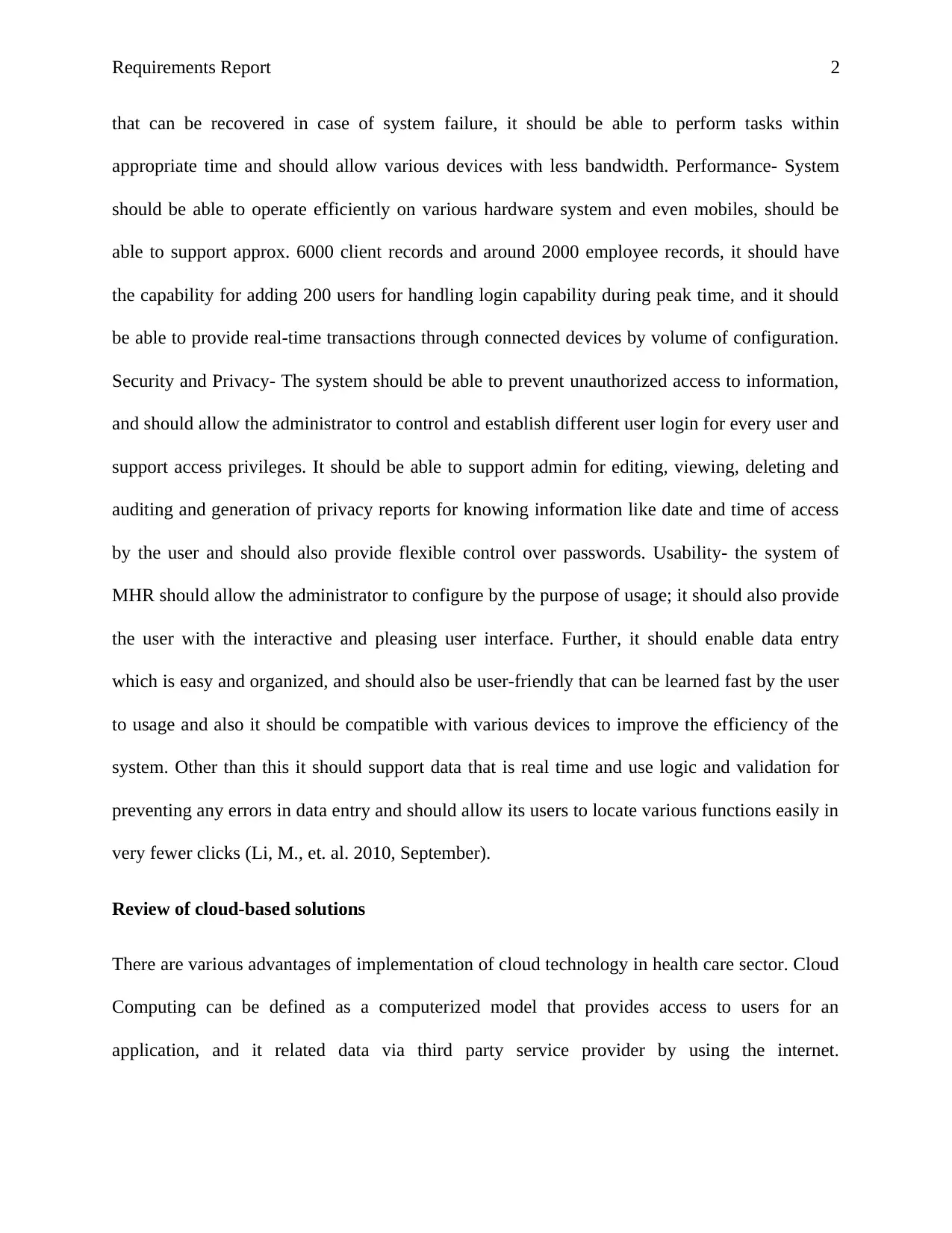
Requirements Report 2
that can be recovered in case of system failure, it should be able to perform tasks within
appropriate time and should allow various devices with less bandwidth. Performance- System
should be able to operate efficiently on various hardware system and even mobiles, should be
able to support approx. 6000 client records and around 2000 employee records, it should have
the capability for adding 200 users for handling login capability during peak time, and it should
be able to provide real-time transactions through connected devices by volume of configuration.
Security and Privacy- The system should be able to prevent unauthorized access to information,
and should allow the administrator to control and establish different user login for every user and
support access privileges. It should be able to support admin for editing, viewing, deleting and
auditing and generation of privacy reports for knowing information like date and time of access
by the user and should also provide flexible control over passwords. Usability- the system of
MHR should allow the administrator to configure by the purpose of usage; it should also provide
the user with the interactive and pleasing user interface. Further, it should enable data entry
which is easy and organized, and should also be user-friendly that can be learned fast by the user
to usage and also it should be compatible with various devices to improve the efficiency of the
system. Other than this it should support data that is real time and use logic and validation for
preventing any errors in data entry and should allow its users to locate various functions easily in
very fewer clicks (Li, M., et. al. 2010, September).
Review of cloud-based solutions
There are various advantages of implementation of cloud technology in health care sector. Cloud
Computing can be defined as a computerized model that provides access to users for an
application, and it related data via third party service provider by using the internet.
that can be recovered in case of system failure, it should be able to perform tasks within
appropriate time and should allow various devices with less bandwidth. Performance- System
should be able to operate efficiently on various hardware system and even mobiles, should be
able to support approx. 6000 client records and around 2000 employee records, it should have
the capability for adding 200 users for handling login capability during peak time, and it should
be able to provide real-time transactions through connected devices by volume of configuration.
Security and Privacy- The system should be able to prevent unauthorized access to information,
and should allow the administrator to control and establish different user login for every user and
support access privileges. It should be able to support admin for editing, viewing, deleting and
auditing and generation of privacy reports for knowing information like date and time of access
by the user and should also provide flexible control over passwords. Usability- the system of
MHR should allow the administrator to configure by the purpose of usage; it should also provide
the user with the interactive and pleasing user interface. Further, it should enable data entry
which is easy and organized, and should also be user-friendly that can be learned fast by the user
to usage and also it should be compatible with various devices to improve the efficiency of the
system. Other than this it should support data that is real time and use logic and validation for
preventing any errors in data entry and should allow its users to locate various functions easily in
very fewer clicks (Li, M., et. al. 2010, September).
Review of cloud-based solutions
There are various advantages of implementation of cloud technology in health care sector. Cloud
Computing can be defined as a computerized model that provides access to users for an
application, and it related data via third party service provider by using the internet.
⊘ This is a preview!⊘
Do you want full access?
Subscribe today to unlock all pages.

Trusted by 1+ million students worldwide
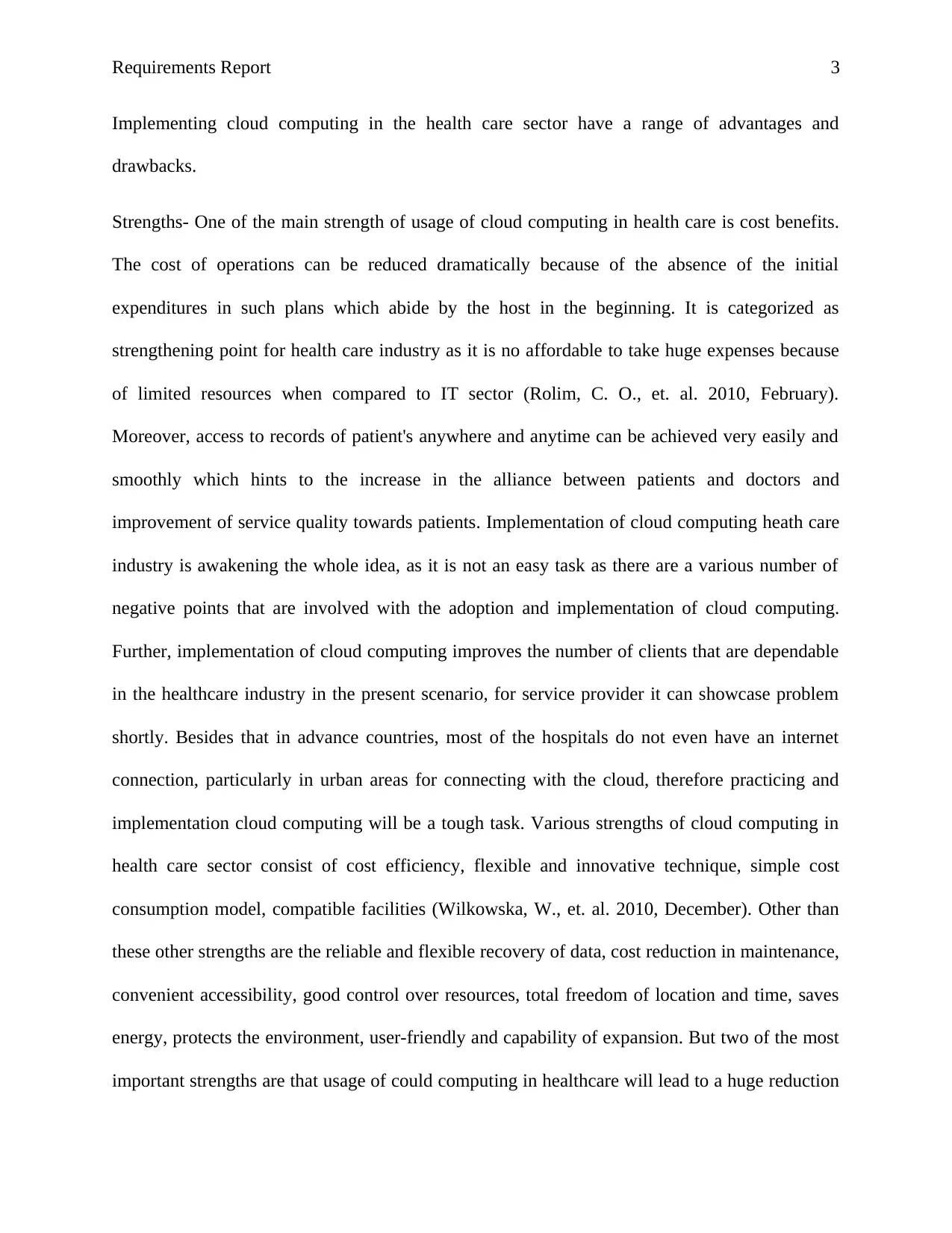
Requirements Report 3
Implementing cloud computing in the health care sector have a range of advantages and
drawbacks.
Strengths- One of the main strength of usage of cloud computing in health care is cost benefits.
The cost of operations can be reduced dramatically because of the absence of the initial
expenditures in such plans which abide by the host in the beginning. It is categorized as
strengthening point for health care industry as it is no affordable to take huge expenses because
of limited resources when compared to IT sector (Rolim, C. O., et. al. 2010, February).
Moreover, access to records of patient's anywhere and anytime can be achieved very easily and
smoothly which hints to the increase in the alliance between patients and doctors and
improvement of service quality towards patients. Implementation of cloud computing heath care
industry is awakening the whole idea, as it is not an easy task as there are a various number of
negative points that are involved with the adoption and implementation of cloud computing.
Further, implementation of cloud computing improves the number of clients that are dependable
in the healthcare industry in the present scenario, for service provider it can showcase problem
shortly. Besides that in advance countries, most of the hospitals do not even have an internet
connection, particularly in urban areas for connecting with the cloud, therefore practicing and
implementation cloud computing will be a tough task. Various strengths of cloud computing in
health care sector consist of cost efficiency, flexible and innovative technique, simple cost
consumption model, compatible facilities (Wilkowska, W., et. al. 2010, December). Other than
these other strengths are the reliable and flexible recovery of data, cost reduction in maintenance,
convenient accessibility, good control over resources, total freedom of location and time, saves
energy, protects the environment, user-friendly and capability of expansion. But two of the most
important strengths are that usage of could computing in healthcare will lead to a huge reduction
Implementing cloud computing in the health care sector have a range of advantages and
drawbacks.
Strengths- One of the main strength of usage of cloud computing in health care is cost benefits.
The cost of operations can be reduced dramatically because of the absence of the initial
expenditures in such plans which abide by the host in the beginning. It is categorized as
strengthening point for health care industry as it is no affordable to take huge expenses because
of limited resources when compared to IT sector (Rolim, C. O., et. al. 2010, February).
Moreover, access to records of patient's anywhere and anytime can be achieved very easily and
smoothly which hints to the increase in the alliance between patients and doctors and
improvement of service quality towards patients. Implementation of cloud computing heath care
industry is awakening the whole idea, as it is not an easy task as there are a various number of
negative points that are involved with the adoption and implementation of cloud computing.
Further, implementation of cloud computing improves the number of clients that are dependable
in the healthcare industry in the present scenario, for service provider it can showcase problem
shortly. Besides that in advance countries, most of the hospitals do not even have an internet
connection, particularly in urban areas for connecting with the cloud, therefore practicing and
implementation cloud computing will be a tough task. Various strengths of cloud computing in
health care sector consist of cost efficiency, flexible and innovative technique, simple cost
consumption model, compatible facilities (Wilkowska, W., et. al. 2010, December). Other than
these other strengths are the reliable and flexible recovery of data, cost reduction in maintenance,
convenient accessibility, good control over resources, total freedom of location and time, saves
energy, protects the environment, user-friendly and capability of expansion. But two of the most
important strengths are that usage of could computing in healthcare will lead to a huge reduction
Paraphrase This Document
Need a fresh take? Get an instant paraphrase of this document with our AI Paraphraser
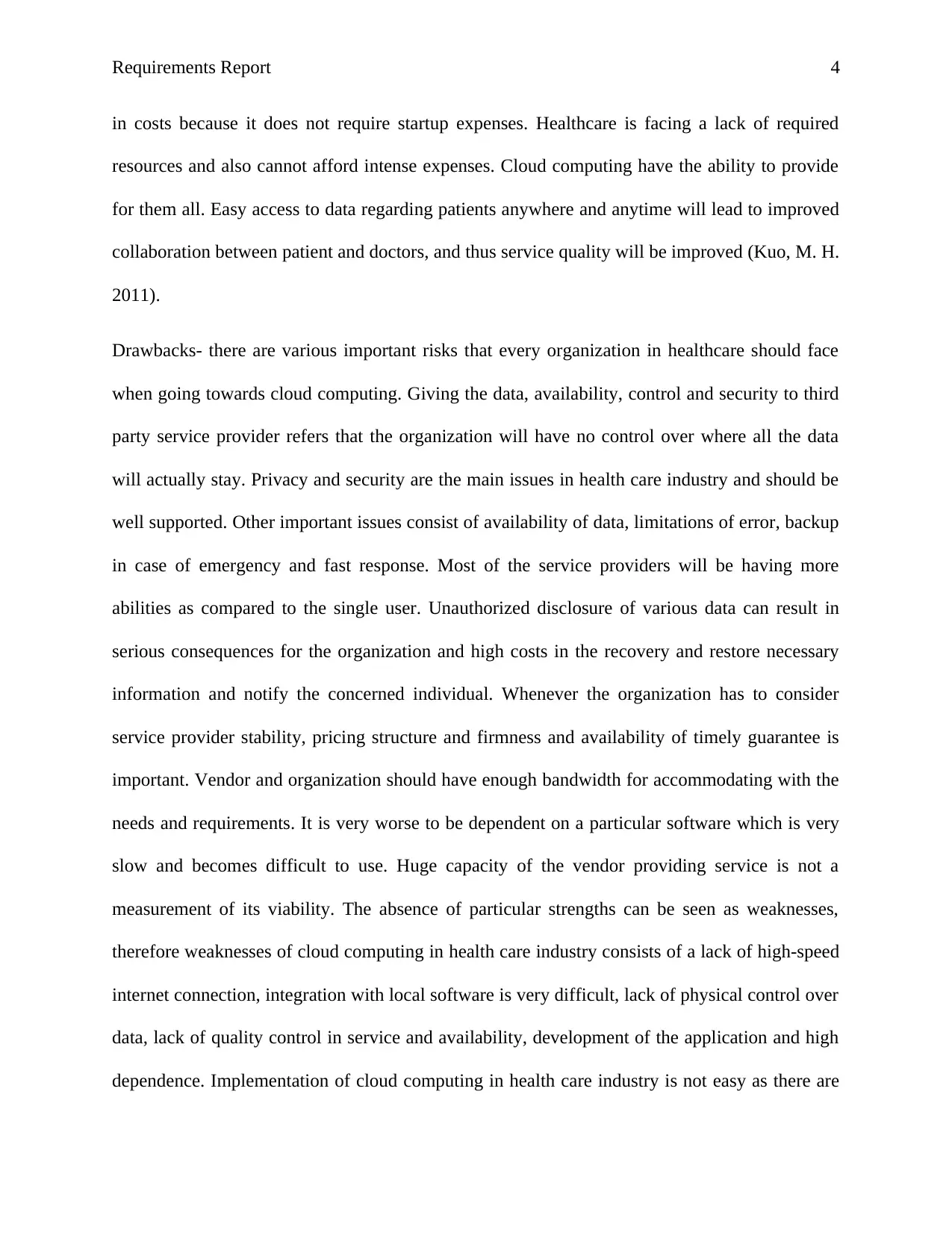
Requirements Report 4
in costs because it does not require startup expenses. Healthcare is facing a lack of required
resources and also cannot afford intense expenses. Cloud computing have the ability to provide
for them all. Easy access to data regarding patients anywhere and anytime will lead to improved
collaboration between patient and doctors, and thus service quality will be improved (Kuo, M. H.
2011).
Drawbacks- there are various important risks that every organization in healthcare should face
when going towards cloud computing. Giving the data, availability, control and security to third
party service provider refers that the organization will have no control over where all the data
will actually stay. Privacy and security are the main issues in health care industry and should be
well supported. Other important issues consist of availability of data, limitations of error, backup
in case of emergency and fast response. Most of the service providers will be having more
abilities as compared to the single user. Unauthorized disclosure of various data can result in
serious consequences for the organization and high costs in the recovery and restore necessary
information and notify the concerned individual. Whenever the organization has to consider
service provider stability, pricing structure and firmness and availability of timely guarantee is
important. Vendor and organization should have enough bandwidth for accommodating with the
needs and requirements. It is very worse to be dependent on a particular software which is very
slow and becomes difficult to use. Huge capacity of the vendor providing service is not a
measurement of its viability. The absence of particular strengths can be seen as weaknesses,
therefore weaknesses of cloud computing in health care industry consists of a lack of high-speed
internet connection, integration with local software is very difficult, lack of physical control over
data, lack of quality control in service and availability, development of the application and high
dependence. Implementation of cloud computing in health care industry is not easy as there are
in costs because it does not require startup expenses. Healthcare is facing a lack of required
resources and also cannot afford intense expenses. Cloud computing have the ability to provide
for them all. Easy access to data regarding patients anywhere and anytime will lead to improved
collaboration between patient and doctors, and thus service quality will be improved (Kuo, M. H.
2011).
Drawbacks- there are various important risks that every organization in healthcare should face
when going towards cloud computing. Giving the data, availability, control and security to third
party service provider refers that the organization will have no control over where all the data
will actually stay. Privacy and security are the main issues in health care industry and should be
well supported. Other important issues consist of availability of data, limitations of error, backup
in case of emergency and fast response. Most of the service providers will be having more
abilities as compared to the single user. Unauthorized disclosure of various data can result in
serious consequences for the organization and high costs in the recovery and restore necessary
information and notify the concerned individual. Whenever the organization has to consider
service provider stability, pricing structure and firmness and availability of timely guarantee is
important. Vendor and organization should have enough bandwidth for accommodating with the
needs and requirements. It is very worse to be dependent on a particular software which is very
slow and becomes difficult to use. Huge capacity of the vendor providing service is not a
measurement of its viability. The absence of particular strengths can be seen as weaknesses,
therefore weaknesses of cloud computing in health care industry consists of a lack of high-speed
internet connection, integration with local software is very difficult, lack of physical control over
data, lack of quality control in service and availability, development of the application and high
dependence. Implementation of cloud computing in health care industry is not easy as there are
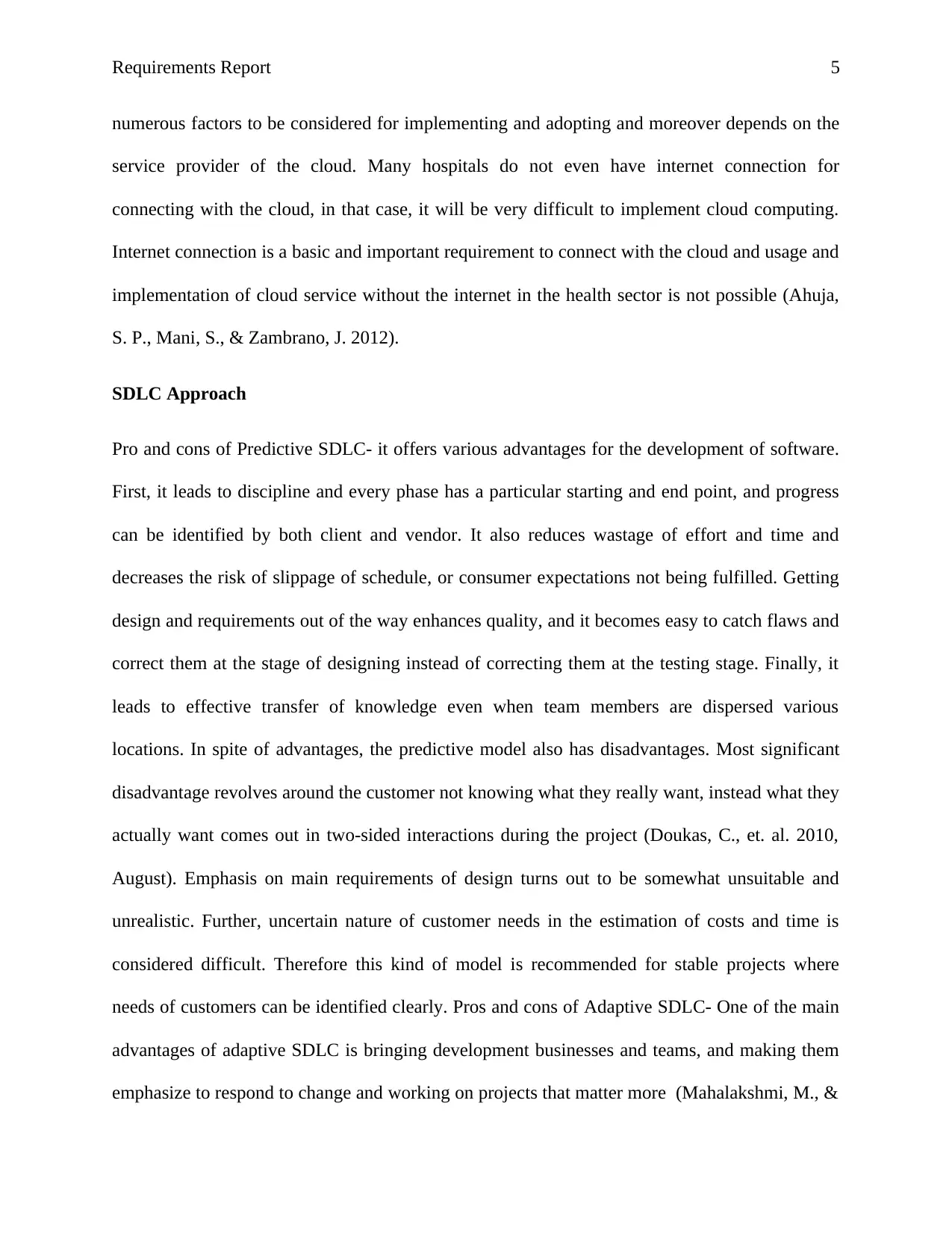
Requirements Report 5
numerous factors to be considered for implementing and adopting and moreover depends on the
service provider of the cloud. Many hospitals do not even have internet connection for
connecting with the cloud, in that case, it will be very difficult to implement cloud computing.
Internet connection is a basic and important requirement to connect with the cloud and usage and
implementation of cloud service without the internet in the health sector is not possible (Ahuja,
S. P., Mani, S., & Zambrano, J. 2012).
SDLC Approach
Pro and cons of Predictive SDLC- it offers various advantages for the development of software.
First, it leads to discipline and every phase has a particular starting and end point, and progress
can be identified by both client and vendor. It also reduces wastage of effort and time and
decreases the risk of slippage of schedule, or consumer expectations not being fulfilled. Getting
design and requirements out of the way enhances quality, and it becomes easy to catch flaws and
correct them at the stage of designing instead of correcting them at the testing stage. Finally, it
leads to effective transfer of knowledge even when team members are dispersed various
locations. In spite of advantages, the predictive model also has disadvantages. Most significant
disadvantage revolves around the customer not knowing what they really want, instead what they
actually want comes out in two-sided interactions during the project (Doukas, C., et. al. 2010,
August). Emphasis on main requirements of design turns out to be somewhat unsuitable and
unrealistic. Further, uncertain nature of customer needs in the estimation of costs and time is
considered difficult. Therefore this kind of model is recommended for stable projects where
needs of customers can be identified clearly. Pros and cons of Adaptive SDLC- One of the main
advantages of adaptive SDLC is bringing development businesses and teams, and making them
emphasize to respond to change and working on projects that matter more (Mahalakshmi, M., &
numerous factors to be considered for implementing and adopting and moreover depends on the
service provider of the cloud. Many hospitals do not even have internet connection for
connecting with the cloud, in that case, it will be very difficult to implement cloud computing.
Internet connection is a basic and important requirement to connect with the cloud and usage and
implementation of cloud service without the internet in the health sector is not possible (Ahuja,
S. P., Mani, S., & Zambrano, J. 2012).
SDLC Approach
Pro and cons of Predictive SDLC- it offers various advantages for the development of software.
First, it leads to discipline and every phase has a particular starting and end point, and progress
can be identified by both client and vendor. It also reduces wastage of effort and time and
decreases the risk of slippage of schedule, or consumer expectations not being fulfilled. Getting
design and requirements out of the way enhances quality, and it becomes easy to catch flaws and
correct them at the stage of designing instead of correcting them at the testing stage. Finally, it
leads to effective transfer of knowledge even when team members are dispersed various
locations. In spite of advantages, the predictive model also has disadvantages. Most significant
disadvantage revolves around the customer not knowing what they really want, instead what they
actually want comes out in two-sided interactions during the project (Doukas, C., et. al. 2010,
August). Emphasis on main requirements of design turns out to be somewhat unsuitable and
unrealistic. Further, uncertain nature of customer needs in the estimation of costs and time is
considered difficult. Therefore this kind of model is recommended for stable projects where
needs of customers can be identified clearly. Pros and cons of Adaptive SDLC- One of the main
advantages of adaptive SDLC is bringing development businesses and teams, and making them
emphasize to respond to change and working on projects that matter more (Mahalakshmi, M., &
⊘ This is a preview!⊘
Do you want full access?
Subscribe today to unlock all pages.

Trusted by 1+ million students worldwide
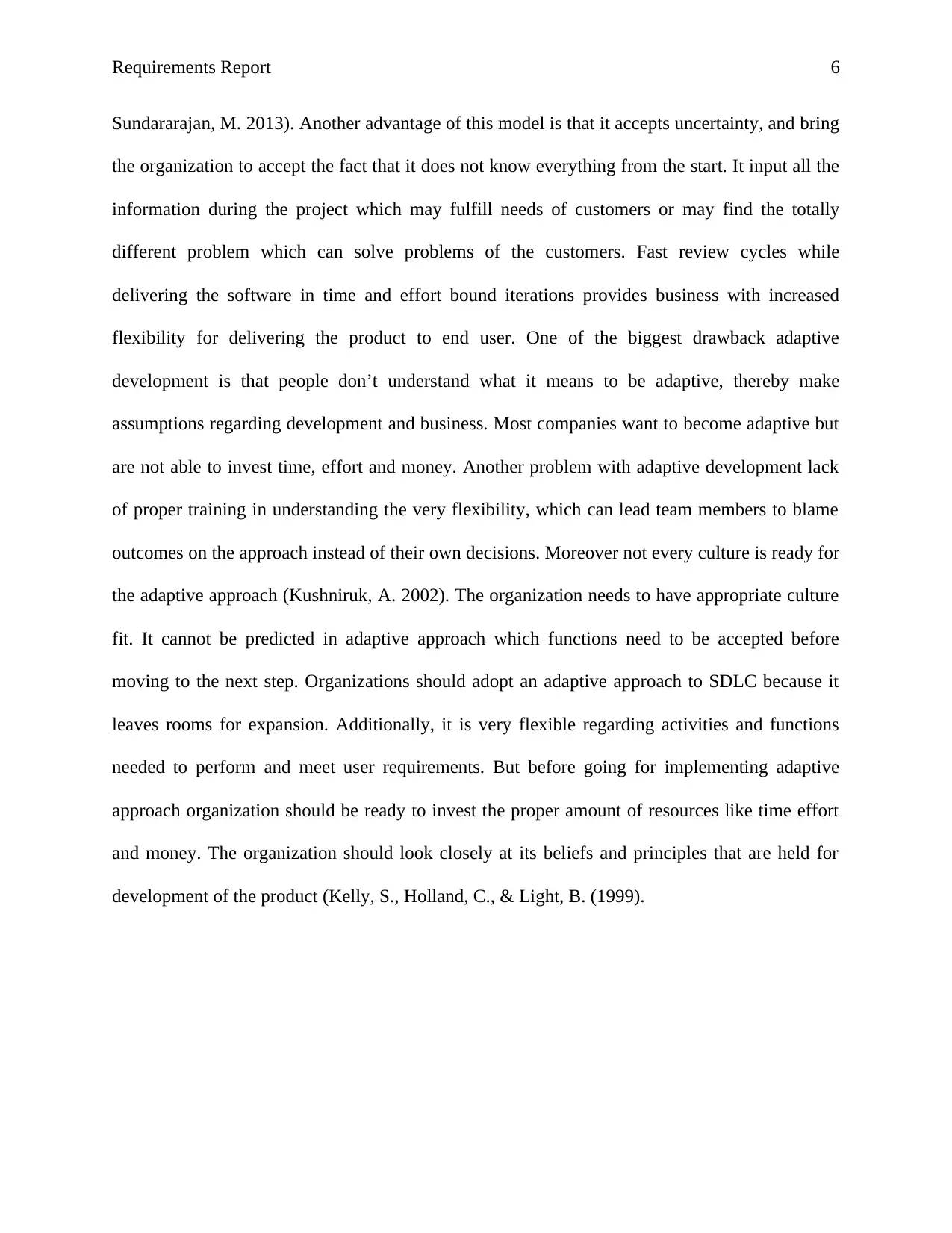
Requirements Report 6
Sundararajan, M. 2013). Another advantage of this model is that it accepts uncertainty, and bring
the organization to accept the fact that it does not know everything from the start. It input all the
information during the project which may fulfill needs of customers or may find the totally
different problem which can solve problems of the customers. Fast review cycles while
delivering the software in time and effort bound iterations provides business with increased
flexibility for delivering the product to end user. One of the biggest drawback adaptive
development is that people don’t understand what it means to be adaptive, thereby make
assumptions regarding development and business. Most companies want to become adaptive but
are not able to invest time, effort and money. Another problem with adaptive development lack
of proper training in understanding the very flexibility, which can lead team members to blame
outcomes on the approach instead of their own decisions. Moreover not every culture is ready for
the adaptive approach (Kushniruk, A. 2002). The organization needs to have appropriate culture
fit. It cannot be predicted in adaptive approach which functions need to be accepted before
moving to the next step. Organizations should adopt an adaptive approach to SDLC because it
leaves rooms for expansion. Additionally, it is very flexible regarding activities and functions
needed to perform and meet user requirements. But before going for implementing adaptive
approach organization should be ready to invest the proper amount of resources like time effort
and money. The organization should look closely at its beliefs and principles that are held for
development of the product (Kelly, S., Holland, C., & Light, B. (1999).
Sundararajan, M. 2013). Another advantage of this model is that it accepts uncertainty, and bring
the organization to accept the fact that it does not know everything from the start. It input all the
information during the project which may fulfill needs of customers or may find the totally
different problem which can solve problems of the customers. Fast review cycles while
delivering the software in time and effort bound iterations provides business with increased
flexibility for delivering the product to end user. One of the biggest drawback adaptive
development is that people don’t understand what it means to be adaptive, thereby make
assumptions regarding development and business. Most companies want to become adaptive but
are not able to invest time, effort and money. Another problem with adaptive development lack
of proper training in understanding the very flexibility, which can lead team members to blame
outcomes on the approach instead of their own decisions. Moreover not every culture is ready for
the adaptive approach (Kushniruk, A. 2002). The organization needs to have appropriate culture
fit. It cannot be predicted in adaptive approach which functions need to be accepted before
moving to the next step. Organizations should adopt an adaptive approach to SDLC because it
leaves rooms for expansion. Additionally, it is very flexible regarding activities and functions
needed to perform and meet user requirements. But before going for implementing adaptive
approach organization should be ready to invest the proper amount of resources like time effort
and money. The organization should look closely at its beliefs and principles that are held for
development of the product (Kelly, S., Holland, C., & Light, B. (1999).
Paraphrase This Document
Need a fresh take? Get an instant paraphrase of this document with our AI Paraphraser
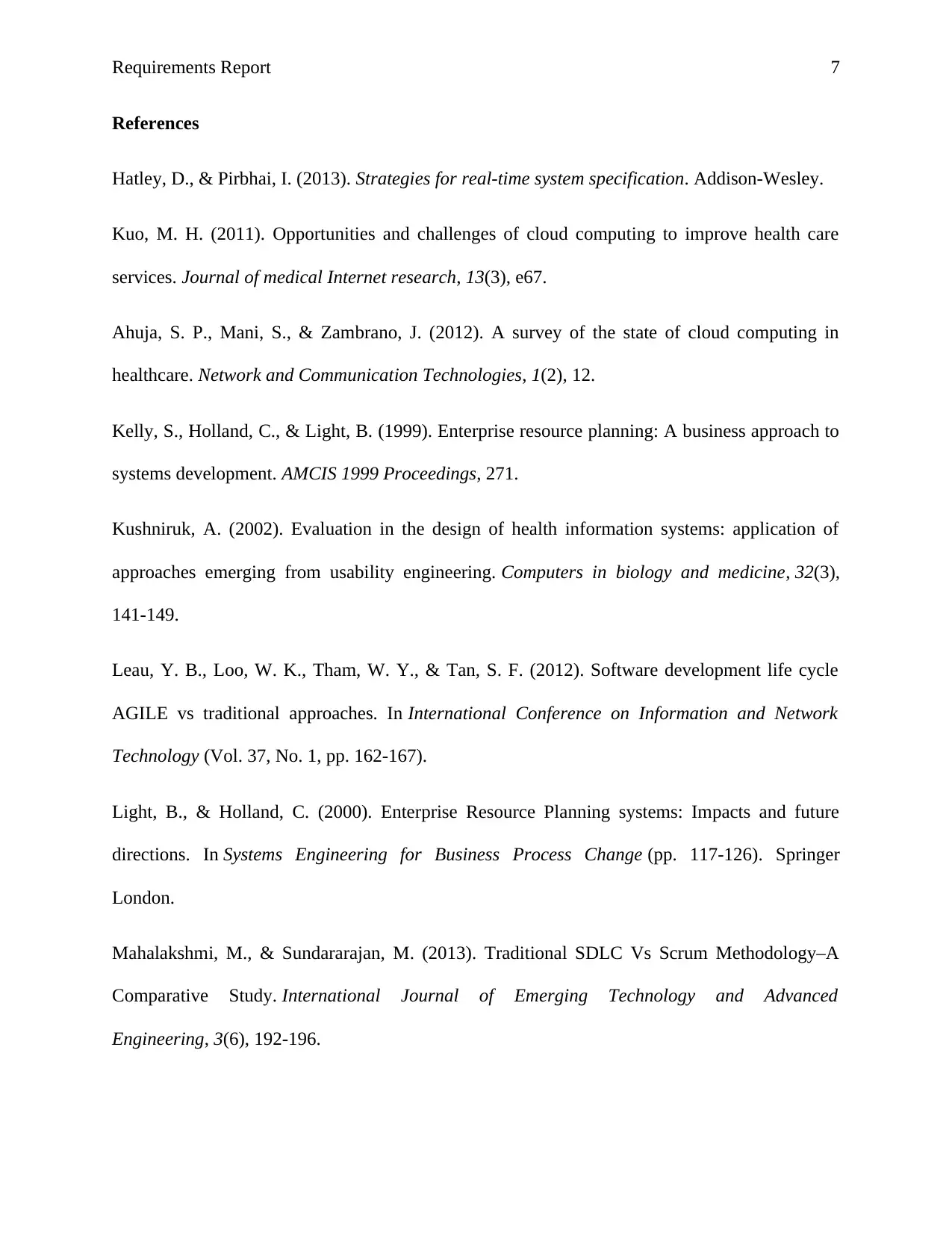
Requirements Report 7
References
Hatley, D., & Pirbhai, I. (2013). Strategies for real-time system specification. Addison-Wesley.
Kuo, M. H. (2011). Opportunities and challenges of cloud computing to improve health care
services. Journal of medical Internet research, 13(3), e67.
Ahuja, S. P., Mani, S., & Zambrano, J. (2012). A survey of the state of cloud computing in
healthcare. Network and Communication Technologies, 1(2), 12.
Kelly, S., Holland, C., & Light, B. (1999). Enterprise resource planning: A business approach to
systems development. AMCIS 1999 Proceedings, 271.
Kushniruk, A. (2002). Evaluation in the design of health information systems: application of
approaches emerging from usability engineering. Computers in biology and medicine, 32(3),
141-149.
Leau, Y. B., Loo, W. K., Tham, W. Y., & Tan, S. F. (2012). Software development life cycle
AGILE vs traditional approaches. In International Conference on Information and Network
Technology (Vol. 37, No. 1, pp. 162-167).
Light, B., & Holland, C. (2000). Enterprise Resource Planning systems: Impacts and future
directions. In Systems Engineering for Business Process Change (pp. 117-126). Springer
London.
Mahalakshmi, M., & Sundararajan, M. (2013). Traditional SDLC Vs Scrum Methodology–A
Comparative Study. International Journal of Emerging Technology and Advanced
Engineering, 3(6), 192-196.
References
Hatley, D., & Pirbhai, I. (2013). Strategies for real-time system specification. Addison-Wesley.
Kuo, M. H. (2011). Opportunities and challenges of cloud computing to improve health care
services. Journal of medical Internet research, 13(3), e67.
Ahuja, S. P., Mani, S., & Zambrano, J. (2012). A survey of the state of cloud computing in
healthcare. Network and Communication Technologies, 1(2), 12.
Kelly, S., Holland, C., & Light, B. (1999). Enterprise resource planning: A business approach to
systems development. AMCIS 1999 Proceedings, 271.
Kushniruk, A. (2002). Evaluation in the design of health information systems: application of
approaches emerging from usability engineering. Computers in biology and medicine, 32(3),
141-149.
Leau, Y. B., Loo, W. K., Tham, W. Y., & Tan, S. F. (2012). Software development life cycle
AGILE vs traditional approaches. In International Conference on Information and Network
Technology (Vol. 37, No. 1, pp. 162-167).
Light, B., & Holland, C. (2000). Enterprise Resource Planning systems: Impacts and future
directions. In Systems Engineering for Business Process Change (pp. 117-126). Springer
London.
Mahalakshmi, M., & Sundararajan, M. (2013). Traditional SDLC Vs Scrum Methodology–A
Comparative Study. International Journal of Emerging Technology and Advanced
Engineering, 3(6), 192-196.
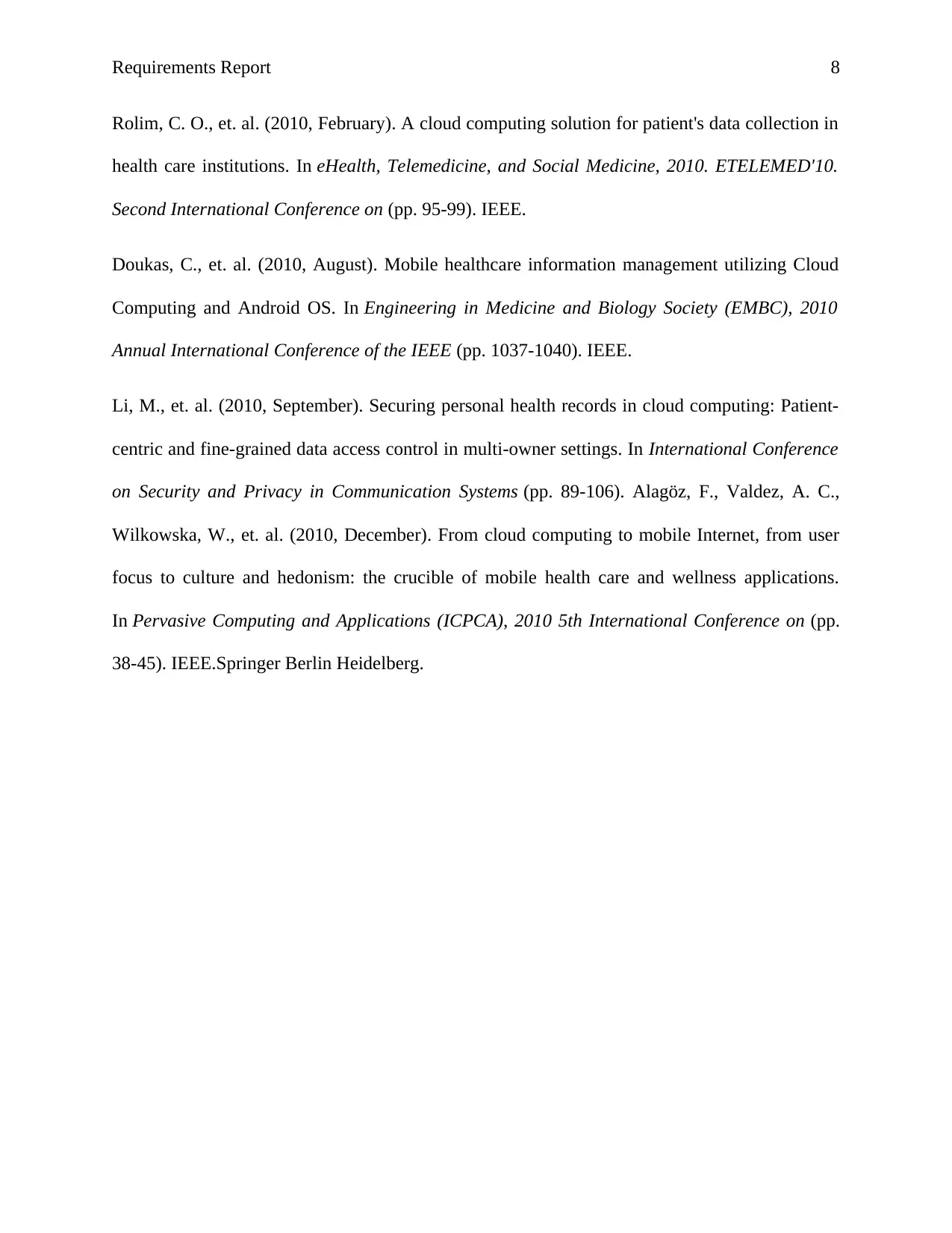
Requirements Report 8
Rolim, C. O., et. al. (2010, February). A cloud computing solution for patient's data collection in
health care institutions. In eHealth, Telemedicine, and Social Medicine, 2010. ETELEMED'10.
Second International Conference on (pp. 95-99). IEEE.
Doukas, C., et. al. (2010, August). Mobile healthcare information management utilizing Cloud
Computing and Android OS. In Engineering in Medicine and Biology Society (EMBC), 2010
Annual International Conference of the IEEE (pp. 1037-1040). IEEE.
Li, M., et. al. (2010, September). Securing personal health records in cloud computing: Patient-
centric and fine-grained data access control in multi-owner settings. In International Conference
on Security and Privacy in Communication Systems (pp. 89-106). Alagöz, F., Valdez, A. C.,
Wilkowska, W., et. al. (2010, December). From cloud computing to mobile Internet, from user
focus to culture and hedonism: the crucible of mobile health care and wellness applications.
In Pervasive Computing and Applications (ICPCA), 2010 5th International Conference on (pp.
38-45). IEEE.Springer Berlin Heidelberg.
Rolim, C. O., et. al. (2010, February). A cloud computing solution for patient's data collection in
health care institutions. In eHealth, Telemedicine, and Social Medicine, 2010. ETELEMED'10.
Second International Conference on (pp. 95-99). IEEE.
Doukas, C., et. al. (2010, August). Mobile healthcare information management utilizing Cloud
Computing and Android OS. In Engineering in Medicine and Biology Society (EMBC), 2010
Annual International Conference of the IEEE (pp. 1037-1040). IEEE.
Li, M., et. al. (2010, September). Securing personal health records in cloud computing: Patient-
centric and fine-grained data access control in multi-owner settings. In International Conference
on Security and Privacy in Communication Systems (pp. 89-106). Alagöz, F., Valdez, A. C.,
Wilkowska, W., et. al. (2010, December). From cloud computing to mobile Internet, from user
focus to culture and hedonism: the crucible of mobile health care and wellness applications.
In Pervasive Computing and Applications (ICPCA), 2010 5th International Conference on (pp.
38-45). IEEE.Springer Berlin Heidelberg.
⊘ This is a preview!⊘
Do you want full access?
Subscribe today to unlock all pages.

Trusted by 1+ million students worldwide
1 out of 9
Related Documents
Your All-in-One AI-Powered Toolkit for Academic Success.
+13062052269
info@desklib.com
Available 24*7 on WhatsApp / Email
![[object Object]](/_next/static/media/star-bottom.7253800d.svg)
Unlock your academic potential
Copyright © 2020–2025 A2Z Services. All Rights Reserved. Developed and managed by ZUCOL.




